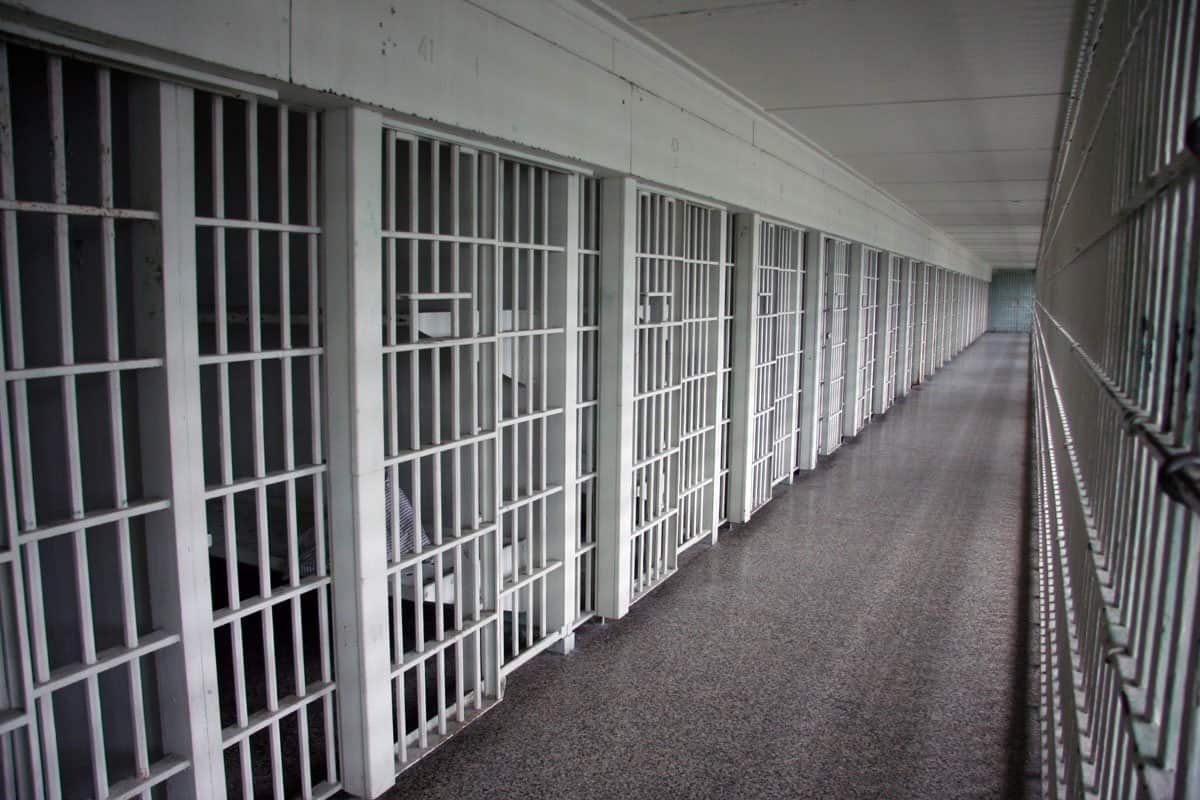
Amy L. Eisenstein is a student at Harvard Law School and a member of the Labor and Employment Lab.
This is the first post in a three-part series on Ruelas v. County of Alameda, in which the California Supreme Court held that pretrial detainees are not guaranteed a minimum wage. You can find Part 2 here and Part 3 here.
Pretrial detainees in Santa Rita Jail are forced to labor for Aramark, a food-preparation company that provides meals to third parties outside of the jail. Neither Aramark nor the county pays detainees for their labor. In 1990, California amended its constitution to allow companies to contract with prisons — facilities run by the state or federal government that detain convicted offenders — for labor, so long as prisoners were paid comparable wages to non-inmate laborers. The amendment, however, left the details of company contracts with jails — local facilities that primarily hold non-convicted individuals awaiting trial or sentencing (“pretrial detainees”) — up to local ordinances. In Ruelas v. County of Alameda, the Supreme Court of California held that absent a local ordinance, pretrial detainees are not eligible for minimum wages under the state’s Labor Code. Instead, the court reasoned, section 4019.3 of the state’s Penal Code caps their potential earnings at two dollars per day.
This first post in a three-part series summarizes the plaintiffs’ claim and the California Supreme Court’s reasoning. The next post analyzes the history of California’s constitution and jail labor in the state, both of which suggest flaws in the court’s reasoning. It argues that the pre-1990 constitutional ban on private “convict” labor applied equally to labor in prisons and labor in jails. Understood in historical context, the ban applied to private labor by pretrial detainees and convicted offenders, both of which this series refers to as “inmates.” The final post analyzes the Penal Code’s legislative history, which suggests that the law imposing a two-dollar wage cap does not apply to pretrial detainees laboring for a corporation. When California legislators passed a two-dollar cap on pretrial detainee wages, they could not have conceived that this cap would apply to private labor — that is, labor for a corporation — because pretrial detainees had only been constitutionally permitted to perform public labor — that is, labor on public works not involving a private contract. The series concludes that the California Supreme Court would have come to a different holding — one that would have entitled plaintiffs to state minimum wages — had it taken full stock of this constitutional and legislative history. The series also suggests that amendment of the Fair Labor Standards Act (FLSA) would preempt consideration of these state law issues and provide incarcerated workers across the nation with more adequate compensation for their labor.
Background
In Santa Rita Jail, pretrial detainees and detainees facing deportation perform “industrial food preparation services and cleaning” for a private, for-profit company called Aramark. At the supervision of Aramark employees, detainees prepare and package food and clean the kitchen without pay. Aramark sets quotas and the detainees sometimes “work in excess of eight hours per day or 40 hours a week, six or seven days a week.” In November 2019, plaintiffs Amida Ruelas, De’Andre Eugene Cox, Bert Davis, Katrish Jones, Joseph Mebrahtu, Dahryl Reynolds, Monica Mason, and Luis Nunez-Romero — all detainees at Santa Rita Jail — filed a complaint in federal district court against the county, the Alameda County Sheriff, and Aramark. The complaint included claims under the Constitution, federal law, and the California Labor Code. The district court denied the dismissal of the minimum wage claims under the California Labor Code. It held that the California Penal Code “cannot be read to preclude” application of the Labor Code here.
The district court certified a question to the Ninth Circuit for interlocutory appeal. The Ninth Circuit then certified the following question for the California Supreme Court’s consideration: “Do non-convicted incarcerated individuals performing services in county jails for a for-profit company to supply meals within the county jails and related custody facilities have a claim for minimum wages and overtime under Section 1194 of the California Labor Code in the absence of any local ordinance prescribing or prohibiting the payment of wages for these individuals?” The answer to this question would not only determine the outcome in this case but also “resolve a novel and important question of California statutory interpretation.”
The Supreme Court of California held that pretrial detainees do not have a minimum wage claim under the Labor Code. Justice Evans “examine[d] the interplay among the Penal Code, the Labor Code, and the constitutional provisions governing public-private contracts for inmate labor.” Enacted in 1959 and amended in 1975, California Penal Code § 4019.3 states: “The board of supervisors may provide that each prisoner confined in or committed to a county jail shall be credited with a sum not to exceed two dollars ($2) for each eight hours of work done by him in such county jail.” Justice Evans concluded that section 4019.3 “creates a discretionary scheme for the payment of wage credits to county jail inmates, subject to a [two-dollar] cap.” She reasoned that the law’s “broad construction” suggests that it applies to pretrial detainees. The court also cited a California Attorney General opinion from 1974 stating that the law applied to “pre-sentence” work time. After examining this evidence, the court concluded that counties “may — but are not required to — credit inmates” up to two dollars per daily shift.
The court rejected plaintiffs’ argument that section 4019.3 is inapplicable to a county jail’s public-private work program. First, the court stated that the limitation does not appear in the statutory text. “In such county jail,” the qualifier stated in section 4019.3, refers to where the work can take place, not who it can be done for. Second, the court rejected plaintiffs’ argument that neighboring statutes — sections 4017 and 4018 — suggest that section 4019.3 should likewise be limited to public works programs. The court reasoned that these neighboring sections apply not only to public works but also to inmates working as firefighters. Even if the neighboring sections did exclusively apply to public works, they would not necessarily restrict the scope of section 4019.3 by proximity.
Third, the court rejected the plaintiffs’ assessment that the California Constitution prohibited public-private partnerships for jail labor at the time the legislature drafted section 4019.3. Echoing defendant Aramark, the court found it “questionable” whether the California Constitution prohibited “labor of convicted persons in county jails, let alone nonconvicted persons such as plaintiffs.” In support of this premise, the court noted that the pre-1990 California Constitution barred “contracting out ‘the labor of convicts . . . to any . . . corporation’” and required the legislature to “‘provide for the working of convicts for the benefit of the State.’” According to Justice Evans, it is unclear whether this ban applied exclusively to state prisoners or also applied to people confined in county jails.
Fourth, the court concluded that section 4019.3 precludes the application of the Labor Code in this case. “A county may not simultaneously comply with Penal Code section 4019.3,” said the court, “and . . . comply with the Labor Code,” because Penal Code section 4019.3 sets a two-dollar (per eight-hour shift) compensation ceiling that conflicts with the much higher minimum wage recoverable under the Labor Code. Thus, section 4019.3 allows the County Board of Supervisors to pay county jail inmates up to a certain wage but does not require that they be paid at all — further support for the premise that the Penal Code, not the Labor Code, governs in this instance.
Finally, the court reasoned that Proposition 139, or the “Prison Inmate Labor Initiative of 1990,” did not obligate local governments to comply with the state Labor Code vis-à-vis county jail labor. In relevant part, Proposition 139 (1) “repealed the constitutional prohibition on contracting for ‘[t]he labor of convicts’”; (2) permitted the Department of Corrections and county governments to contract with private entities for prison labor; (3) required that state prisoners be paid “comparable wages” to non-inmate employees of the same employer; and (4) provided that, in addition to “statutes enacted by or in accordance with the Prison Inmate Labor Initiative of 1990,” public-private programs “shall be operated and implemented pursuant to . . . local ordinances.” The court reasoned that section 4019.3 is “in accordance with” Proposition 139 and, by extension, Article XIV, section 5 of the California Constitution. Furthermore, Proposition 139 left open the issue of county jail detainee wages to local governments. The court concluded that absent a local ordinance, Penal Code section 4019.3, not the Labor Code, governs. Notwithstanding the policy concerns raised by the plaintiffs, the court held that non-convicted incarcerated people working in county jails for a for-profit company are ineligible for minimum wages under the California Labor Code. Contrary to the Ruelas court’s holding, the history of California’s constitution and Penal Code suggest that these pretrial detainees should be entitled to the state’s minimum wage. The California Constitution banned private contracting for “the labor of convicts” until 1990, and the history of inmate labor in California suggests that this ban applied to both prison and jail labor. When California legislators passed section 4019.3 in the mid-twentieth century, then, they likely imagined the two-dollar wage cap applied only to inmate labor in public, not private, works. The latter was constitutionally prohibited and thus inconceivable. The legislative history of section 4019.3 also suggests as much. Given the evidence elaborated in parts two and three, this series argues that the California Supreme Court could and should have decided this case differently, such that the plaintiffs would be eligible to recover minimum wages for their forced labor.










Daily News & Commentary
Start your day with our roundup of the latest labor developments. See all
December 22
Worker-friendly legislation enacted in New York; UW Professor wins free speech case; Trucking company ordered to pay $23 million to Teamsters.
December 21
Argentine unions march against labor law reform; WNBA players vote to authorize a strike; and the NLRB prepares to clear its backlog.
December 19
Labor law professors file an amici curiae and the NLRB regains quorum.
December 18
New Jersey adopts disparate impact rules; Teamsters oppose railroad merger; court pauses more shutdown layoffs.
December 17
The TSA suspends a labor union representing 47,000 officers for a second time; the Trump administration seeks to recruit over 1,000 artificial intelligence experts to the federal workforce; and the New York Times reports on the tumultuous changes that U.S. labor relations has seen over the past year.
December 16
Second Circuit affirms dismissal of former collegiate athletes’ antitrust suit; UPS will invest $120 million in truck-unloading robots; Sharon Block argues there are reasons for optimism about labor’s future.